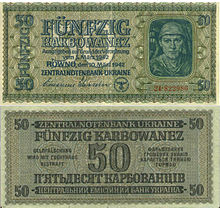Karbowanez
Karbowanez (singular and plural equal; Ukrainian singular: Карбованець Karbowanez , plural: Karbowanzi / Karbowanziw ) was a currency unit of Ukraine in three different epochs of the 20th century.
The term Karbowanez originated in the 18th century, when ruble coins with crooked notches (“karb, -en” in Russian and Ukrainian) were issued on the edge instead of marginal inscriptions, which is why these coins were called “Karbowanez”.
In the turmoil after the October Revolution in the Ukrainian People's Republic , which had been founded on Russian territory, the first currency was called Karbovanets . After the merger with on the former Habsburg territory incurred West Ukrainian People's Republic on 22 January 1918, the Central Council decided on 1 March 1918, the introduction of a new currency: the hryvnia worth half Karbowanez. For the time being, Karbovanets continued to be issued, which then circulated at the same time as the hryvnia.
Issue of banknotes in chronological order:
- Jan. 05, 1918 - 100 Karbowanez
- April 6, 1918 - 25 and 50 Karbowanez
- October 17, 1918 - 10, 100 and 500 hryvnia
- October 1918 - 1000 and 2000 hryvnia
- August 1919 - 10, 100, 250 and 1000 Karbowanez
- October 1919 - 25 Karbowanez
After the annexation to the Soviet Union , the "Bolshevik Thousand" initially applied in the Ukraine, which, however, had a very bad course towards the Karbowanez. There were again currency reforms between 1922 and 1924, which first introduced the Soviet Chervonetz , then the Soviet Karbovanets and later finally the ruble .
At the time of the German occupation from 1942 to 1945, the Central Bank of Ukraine based in Rovno (today's name Rivne ) issued Karbovanets banknotes (1, 2, 5, 10, 20, 50, 100, 200 and 500). These had been printed in the Reichsdruckerei in Berlin. The 2 Karbowanez banknote was never put into circulation. The Karbovanets were introduced on July 25, 1942, the population of the Reichskommissariat Ukraine had to deliver all Soviet banknotes with a value over 5 rubles. Like parts of the salaries of Eastern workers, these were credited to blocked accounts of the Central Economic Bank of Ukraine against receipts, but were never paid out. That is why Reichsmark notes, Karbowanez, Soviet notes of 1 and 3 rubles, Soviet small change and German small coins of 1, 5 and 10 pfennigs made of zinc were in circulation. The official rate was 10 Reichspfennig = 1 Karbowanez = 1 ruble.
The Karbowanez circulated exclusively on the territory of the "Reichskommissariat Ukraine". The current rate was very volatile, and in the spring of 1944 the Karbowanets became almost worthless (the Soviet ruble as well). In May 1944 the mass rejection of the Karbowanez and Reichsmark notes and the 1, 5 and 10 pfennig coins began. After the liberation of the Ukraine, the Karbowanez and Reichsmark notes were suspended and destroyed. The owners of Karbowanez were mostly arrested by the Soviet secret police NKVD and tried as collaborators. The death penalty was imposed on Karbowanez's possession.
After the dissolution of the Soviet Union in 1991 and the establishment of a new Ukrainian state, a transitional currency ( Coupon-Karbowanez / купоно-карбованець ) was introduced in 1992 , which suffered from hyperinflation due to the economic crisis during this period . The mean annual rate in 1992 was 135 coupons for one Deutsche Mark , in 1995 there were 102,886 coupons for one DM. In 1996 the Karbowanez was replaced by the Hryvnia .
Karbovanets of post-Soviet Ukraine
Individual evidence
- ↑ Archived copy ( Memento of the original from October 22, 2008 in the Internet Archive ) Info: The archive link was inserted automatically and has not yet been checked. Please check the original and archive link according to the instructions and then remove this notice.















